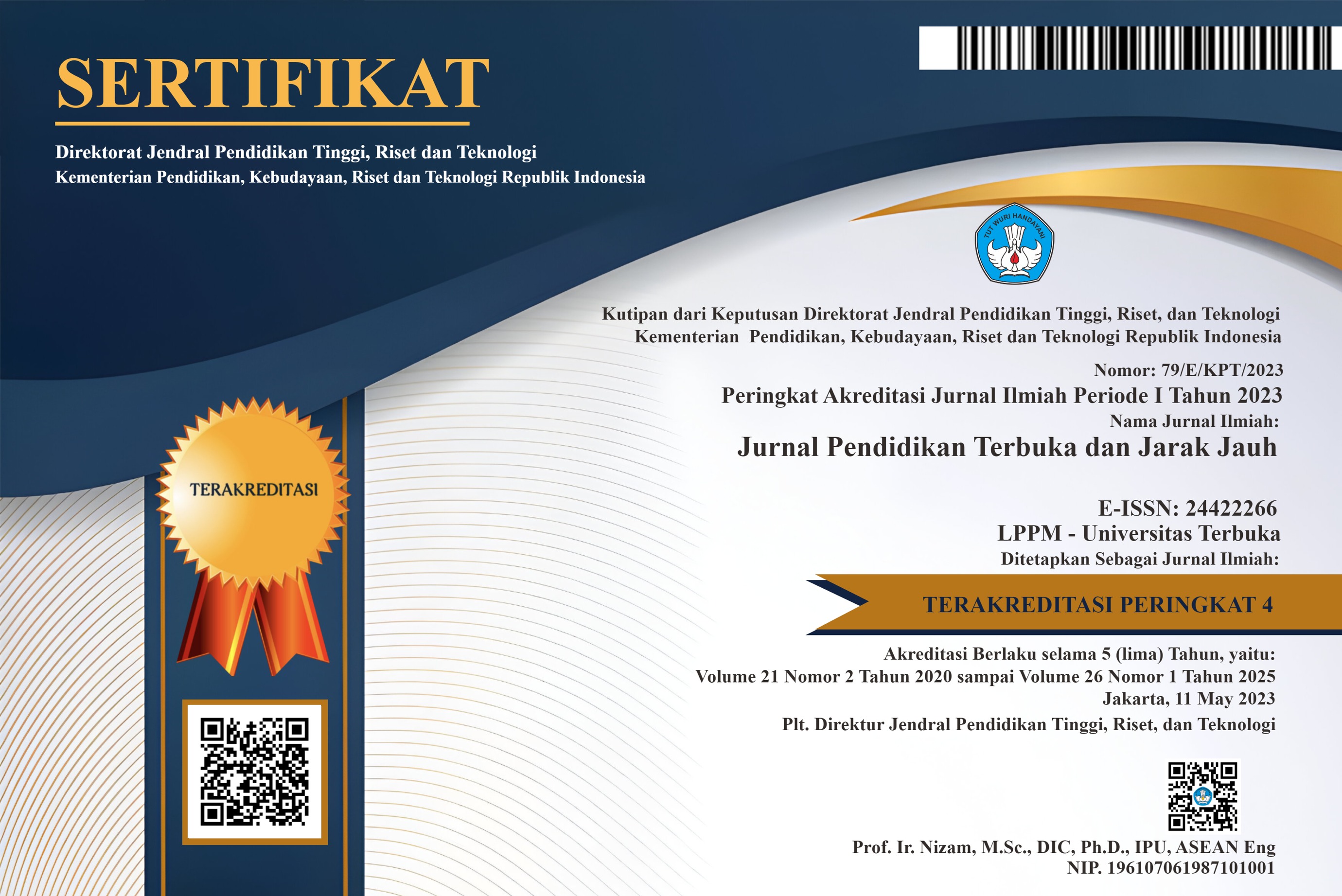KEHADIRAN SOSIAL DALAM PEMBELAJARAN DARING BERDASARKAN SUDUT PANDANG PEMBELAJAR PENDIDIKAN TERBUKA DAN JARAK JAUH
DOI:
https://doi.org/10.33830/ptjj.v19i1.310.2018Keywords:
COI Framework, community of inquiry, online learning, social presenceAbstract
This research describes whether the social presence can be obtained from online learning of distance education setting. Data in this study employed questionnaire adapted from Rovai (2002) which identified 3 aspects of social presence, namely connectedness aspect, learning aspect, and socio-emotional aspect. Data was taken from 60 students who participated in an 8-weeks online learning. The results showed that all aspects have positive attitudes from students’ point of views. The students experienced connectedness aspect, learning aspect, and socio-emotional aspect in online learning regardless the learning situation which was mostly text-based setting.
References
Aydin, I. E & Gumus, S. (2016). Sense of Clasroom Community and Team Development Process In Online Learning. Turkish Online Journal of Distance Education (TOJDE), (17), (1), (5), 60-77.
Denoyelles, A., Zydney, J.M., Chen, B. (2014). Strategies for Creating A Community of Inquiry Through Online Asynchronous Discussions. MERLOT Journal of Online Learning and Teaching. 10, 1, 153-165.
Garrison, D.R., Anderson, T., & Archer, W. (2000). Critical Inquiry in a Text-Based Environment: Computer Conferencing in Higher Education. The Internet and Higher Education, 2(2-3): 87-105.
Garrison, D.R., Anderson, T., & Archer, W. (2010). The First Decade of The Community of Inquiry Framework: A Retrospective. Internet and Higher Education , 13, 5-9.
Gibbs, G. (1995). Assessing Student Centred Courses. Oxford: Oxford Centre for Staff Learning and Development.
Gunawardena, C.N. & Zittle, F. (1997). Social Presence as A Predictor of Satisfaction Within A Computer Mediated Conferencing Environment. American Journal of Distance Education, 11, 3, 8-25.
Hussein, R. Aditiawarman, U., & Mohamed, N. (2007). E-learning Acceptance In A Developing Country: A Case of The Indonesian Open University. Dipresentasikan dalam konferensi German e-Science, Baden, Germany, May2–4, 2007.
Kosasih, L., Iqbal, M. 2013. E-learning Dengan Menggunakan COI Framework. ComTEch (4), (2), 856-866.
Kreijns, K., Acker, F.V., Vermeulen, M., Buuren, H.V. (2014). Community of Inquiry: Social Presence Revisited. E-learning and Digital Media, (11), (1), 5-18.
Rovai, A.P. (2002). Development of An Instrument To Measure Classroom Community. The Internet and Higher Education, (5), 197-211.
Scollins-Mantha, B. (2008). Cultivating social presence in the online learning classroom: A
literature review with recommendations for practice. International Journal of Instructional Technology and Distance Learning, 5(3), 1-15.
Short, J., Wiliams, E., & Christie, B. (1976). The Social Psychology of Telecommunications. London: John Wiley & Sons.
Swan, K & Shih, L. F. (2005). On The Nature and Development of Social Presence in Online Course Discussions. Journal or Asynchronous Learning Networks, 9(3), 115-136.
Tantri, N.R. (2018). How Far Do We Utilize The E-Learning Platform To Achieve 21st Century Skills in Teaching and Learning Process in School Context? A Conceptual Review. Diperesentasikan dalam English Teacher’s Best Practices, Universitas Negeri Surabaya.
Zydney, J.M. Denoyelles, A., & Seo, K. (2012). Creating A Community of Inquiry in Online Environments: An Explorator Study on The Effect of Protocols on Interactions With Asynchronous Discussions. Computers & Education, 58, 1, 77-87.





